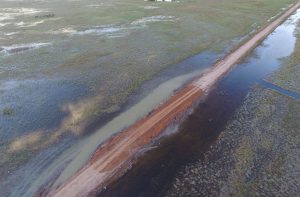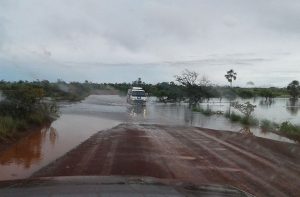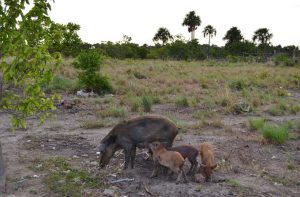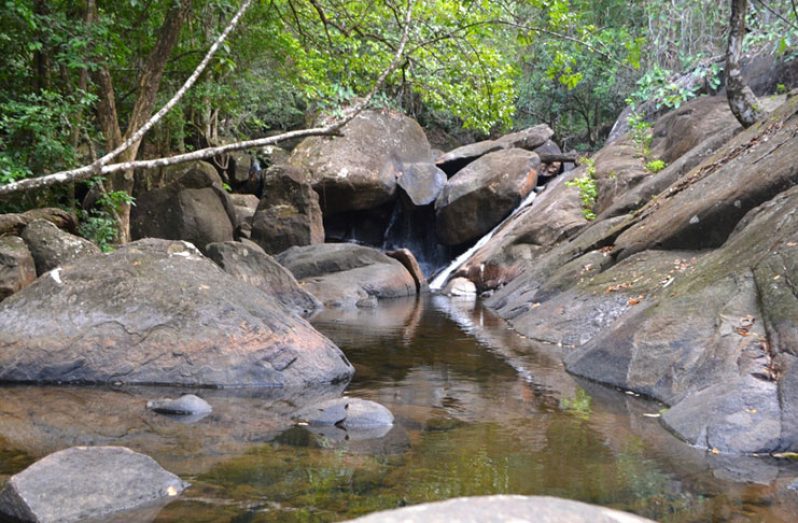— how the Rupununi benefits from flooding
IN June this year, prolonged rains left many Rupununi farmlands under water, families were forced to reap their crops of cassava — an essential staple — much earlier into their life cycle. Main roadways at villages across the region were cut off in some instances. A month later, minibus drivers exerted grit as they forced the small vehicles through the

thick slush of the region’s flooded Hunt Oil stretch, an important stretch of road which was covered by the rising floodwaters.But while the losses in Region Nine (Upper Essequibo –Upper Takutu) have been an annual bugbear for the authorities — mainly from an economic standpoint — one aspect of life in this tourism-rich biodiversity zone of Guyana’s most southern region is its rich eco-system.The rainy season in the Rupununi runs from April to September annually and the rains are usually moderate.
They are usually heavy between May through August and change gradually thereafter.However, conditions are changing faster than expected. This past week, the Rupununi experienced several days of sunlight which left the landscape dry, at least for a few days. Concerns for residents are that the rains have eased considerably and another period of dry weather may be on the horizon. “Right now the rains cut, which should not have been,” said Verlina Jerry, a resident of Lethem, a town in Region Nine on the southern border of Guyana.
“We had a shower of rain last Friday around lunch and an hour later the place was dry,” Jerry said this past weekend. She said the rainy season runs through to late September and she predicted that it would have been raining at the moment.Another resident of

Lethem, Onika Salty, was equally concerned. “For the longest while we hadn’t any rain,” Salty said this past Sunday. The landscape in the area was very dry. Salty expressed concern that the animals will suffer, since the water sources in most areas are likely to dry out.
It was noted too that the rains which annually pours during September, have not been witnessed in the region in recent years. In June this year, Conservation International Guyana noted that flood events in the Rupununi which prevailed at the time, are a natural, regularly occurring and a necessary process for the replenishment of key ecosystem services for the savannahs, forests, wetlands and waterways.
According to research, the Rupununi savannahs encompass 5000 square miles of virtually untouched grasslands, swamp lands, rainforested mountains and are inhabited by some 15,000 Wapisiana, Macushi and Wai-Wai indigenous peoples.In March this year, the World Wildlife Fund (WWF) office in Guyana in collaboration with Global Wildlife Conservation (GWC) highlighted in a report, some of the most striking characteristics of the South

Rupununi savannah region, especially focusing on its diversity of habitats, reflected in the high-species richness and ecological diversity of the flora and fauna.Many species were recorded for the first time in Guyana and the South Rupununi.In addition, at least 59 species of plants and 72 species of animals were identified by communities in the region as important for food, construction, medicine and income-generation.
This entire group has been threatened over the years by high volumes of floodwaters, the effect of climate change.2011 FLOODSIn 2011, the Rupununi experienced the brunt of extreme weather conditions. That year, floodwaters swamped the entire landscape, an experience which the elderly in the region noted at the time was a first in their lifetime of experiences. It was the result of a combination of factors, including the overtopping of waterways, including the Takutu River, which lies between Guyana and Brazil, an unusual, persistent rainy season as well as poor drainage and irrigation facilities. In mid-2015, the region experienced the total opposite of the 2011 situation — a drought.
Dry weather left the landscape in most villages scorched, the famous Kumu Falls trickled, all of which prompted an environmental response from the authorities which was aimed at providing water to villages for various purposes, but mainly for human use and consumption. The conditions had a direct effect on animal life.As the El Nino dry-weather conditions peaked later in 2015, rescuers were forced to fetch the heavy arapaima, an endangered freshwater fish, from the dried-out waterways to other areas where the water levels were high enough to foster their existence. In February 2016, a similar exercise was undertaken, according to the North Rupununi District Development Board (NRDDB), which said that the endangered fish were relocated from a dry pond to the Rewa River due to drought conditions.Water levels were so low that the rescue team had to push and drag boats over a day and a half to reach the stranded arapaimas.

The situation stretched until mid-2016, and during this period, residents were forced to extend the depths of their wells, rely on government services for water as well as fetch water from great distances.JULY 2017 Fast forward to July 2017. Buses were stuck on the Lethem-Georgetown trail. Fuel tankers were unable to brave the swamp-like conditions of the trail closer to Lethem, the region’s only town and administrative capital. “We are hoping that it improves,” Regional Chairman Bryan Allicock told the Guyana Chronicle last month as the rains poured on the outskirts of Lethem. The Hunt Oil Stretch of road located on the outskirts of Lethem was cut off, as water swamped the area. The rains posed further headaches for road users, mainly the operators of passenger buses which traverse this problematic stretch. Two weeks ago, the regional chairman was adamant that the conditions on the road would improve.
He was correct. The authorities were able to repair this section of the road last week, reconnecting the economic linkage between the Rupununi and the coastland.But while residents and the authorities have been battling the effects of wet- weather conditions, it is the eco-system in the country’s richest biodiversity zone that benefits heavily from the flood conditions.According to UN Environment, the United Nations agency which coordinates its environmental activities globally, freshwater eco-systems are constantly under threat. “Climatic changes lead to permanent shifts in freshwater conditions, depleting biodiversity and impacting the proper functioning of freshwater ecosystems, as well as manifesting themselves in more frequent and severe extreme events such as drought and floods,” UN Environment notes.This picture illustrates the struggles for survival of the Rupununi arapaimas. TOO MUCH WATER The Rupununi is feeling the effects of unusual weather, Aishalton resident Tony James noted recently. He told the Guyana Chronicle that several farmlands along the 180km distance between Lethem and Aishalton were inundated.
At Annai, Michael Williams of the NRDDB noted two weeks ago that the rains were pouring at the North Rupununi village. He noted that the village was “becoming a ghost village” as the residents were all in the fields making “farine,”baking cassava-bread and making all sorts of local beverages. “Children enjoying catching fishes and clapping mosquitoes,” he said.It was a stark picture of the simple way of life of the people of the Rupununi. While some are concerned about the livelihoods of the region’s peoples, many believe that the future of plant and animal life rests in the hands of the Almighty. Picture name: Rupununi 2Caption: Men spring into action as the driver of a fuel tanker navigates the Hunt Oil stretch near Lethem late last month.



.jpg)








